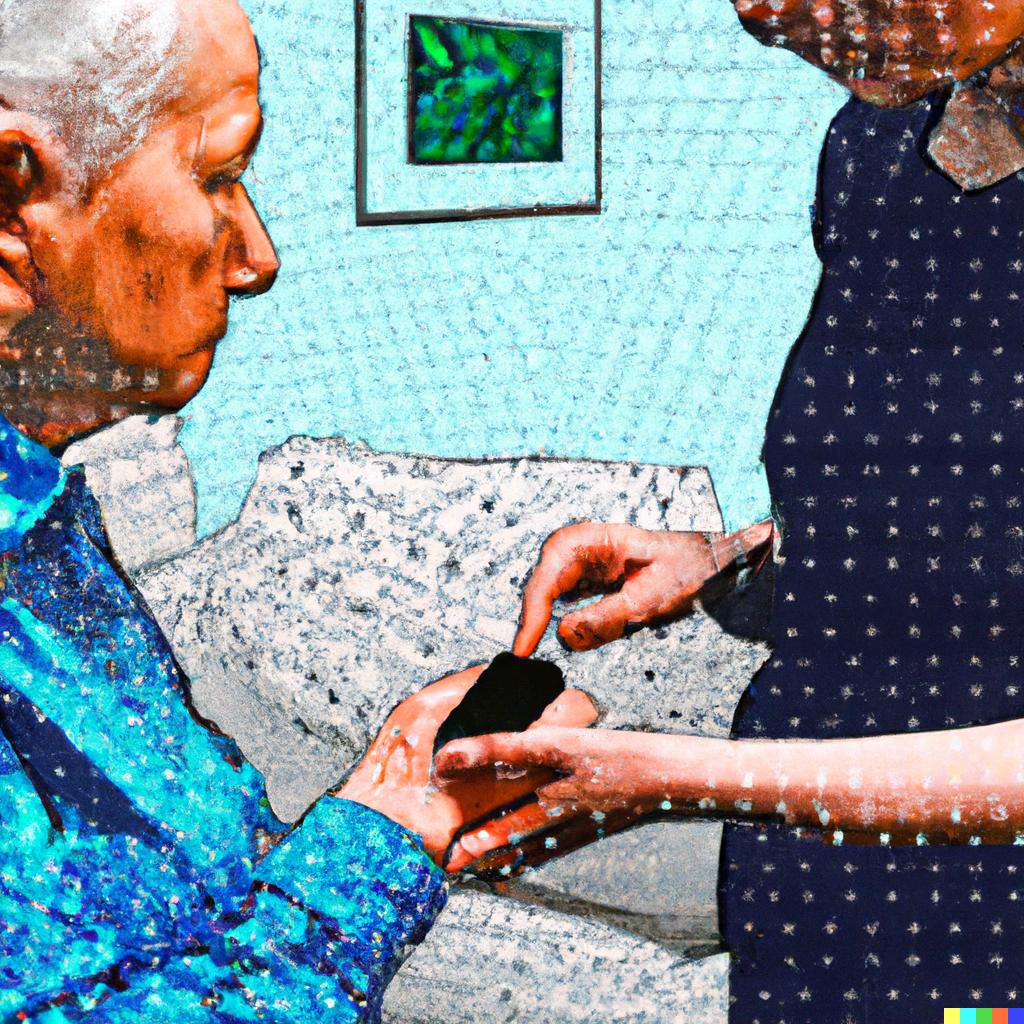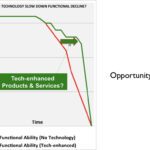By: Richard Caro | Posted: June 13, 2023 | Updated: June 20, 2023
In the “smarthome” section of Tech-enhanced Life, Longevity Explorers have reported on how they have used different smarthome features to improve the quality of life of people in a variety of life situations.
Examples include: people with vision impairments; people with hearing difficulties; people with limited mobility; and people facing early cognition impairment — as well as people who just find these new capabilities “fun” and “useful”, and people who want richer interactions with other people and the world around them.
In reviewing this body of community-sourced content, we are struck by the diverse applications that can be enabled by the combination of voice activated commands and the embryonic “smartness” (Artificial Intelligence (“AI”)) of devices like the Amazon Alexa.
As AI becomes more powerful, we believe that the potential for smarthome technology to improve the quality of life of older adults will grow rapidly.
Overcoming Key Adoption Barrier: DIY Abilities
However, at present there is a “barrier” to widespread adoption of the smarthome features that can benefit older adults the most.
That barrier is the fact that most of the interesting applications require an element of Do-it-Yourself (“DIY”) capability — either by the older adult or by a family member or friend.
As we have watched the Longevity Explorers deploy various DIY smarthome features for themselves or their parents, it has become clear to us that there is a big opportunity to broaden the deployment of these empowering smarthome features to others — by using a “smarthome features as a service” model.
This Article explains our thinking, and describes a pilot project we are considering in partnership with one of the Villages in Northern California.
The Opportunity
To understand the potential of smarthome features to improve the quality of life of older adults, the best place to start is with our article on Smart Home for Seniors: What, Why?. And to learn about the specific DIY solutions our explorers have been deploying, you can see many examples at “DIY Technology Solutions to Things Bothering My Aging Relatives“.
Solutions range from safety-focused ideas like automatic lighting, or sensors to detect water leaks, to convenience features (voice activated lights, or shades). Many of the solutions fit into a category we think of as “enabling autonomy” — letting people do for themselves what previously others had to do for them.
Empowering People and Enabling Autonomy
We think the solutions that “empower” people are especially important.
One example of this is the explorer who told us about her elderly relation who was unable to open her window shades by herself. A caregiver came daily to cook meals and clean, and when she left at 3pm she closed the shades for the lady.
The Longevity Explorer installed a voice-activated shade control, and now the lady can open or close her own window shades — when she wants to, rather than when it is convenient for the caregiver.
“You can’t believe how great it feels not to be dependent on the kindness of strangers, she said”
And there are many other “empowering” examples if you browse the articles linked to above.
Examples (some of which do not quite exist as yet, but could) include:
- replace the need to vacuum by a robot vacuum;
- replace tedious tasks with automation (cooking, cleaning, taking out the trash);
- automate temperature control with a senior-friendly interface;
- enable better communication with family who live at a distance.
You can find examples of many of these described in detail by following the links above.
The Problem
The biggest problem with wider adoption of the sort of smarthome features the Longevity Explorers find useful is the requirement for DIY tech-savvy-ness to deploy them.
Many people assume that these smarthome features can be deployed by simply buying a few gadgets from companies that make them (like Google and Amazon and Apple). And for the simplest of capabilities, this may well be true, although even then there is a setup step that many find daunting.
BUT, the more interesting solutions being deployed by various Longevity Explorers typically include multiple elements that need to work together:
- a primary gadget (an Alexa or Nest etc); PLUS
- some other secondary gadgets made by other companies (an actuator for the shades, or a special light bulb etc); PLUS
- some simple software routines that are customized for the task (Alexa Routines for example); PLUS
- an initial deployment step in which it all gets put in place and some parameters are set, and voice commands programmed.
For a technically-minded person, these multiple steps are very feasible. However for a non-technical person they are daunting. And for older adults with the sort of limitations that make these smarthome features especially valuable (vision, hearing, mobility, cognition), deployment definitely needs a DIY-capable adult child or friend, and there is often a need for ongoing “checking and maybe fixing” when things stop working.
For this reason, most of the examples from our Longevity Explorer community either involve a tech-savvy family member, or require the older adult themselves to be tech-savvy.
This greatly limits the deployment of these capabilities!
The Solution
The obvious “solution” here is some type of “person” who one would retain to do the DIY steps for you, and be available to fix things when they go wrong.
BUT, there are some issues.
- The Smarthome Feature “Recipes”;
- The human capital;
- The business model.
For some time, we have been wondering why this type of “smarthome features as a service” model has not yet emerged.
One possibility is that as yet the “recipes” for the smarthome features are still the domain of DIY people like our explorers. And without the “recipes” and an understanding of the “unmet needs people want solutions for”, offering smarthome features as a service is doomed to failure.
Recipes
We have realized that the Tech-enhanced Life community is in a unique position to identify a handful of “especially valuable use cases”; and create some “standardized smarthome feature recipes” for those unmet needs.
This will take some work, and we hope to do this as part of a “pilot” in collaboration with an organization that can handle the human capital and business model aspects.
Human Capital
Smarthome features as a service needs a cadre of people who understand older adults, and who can do elementary technical deployment.
The combination of these two skill sets is not common.
However, increasingly we see organizations with a tech-capable service workforce starting to think about the needs of older adults (eg Best Buy). And we see organizations who understand the needs of older adults (the aging services industry and governments) starting to think about technology and how to support it.
We think smarthome features as a service for older adults could be a valuable additional offering for either of these types of organization.
If you belong to an organization like these and are interested in getting involved with our “Pilot”, see below for how to contact us.
Business Model
What is the right business model for smarthome features as a service?
One approach is for older adults and their families to pay an organization to decide what smarthome features they might benefit from, and then deploy and support them.
We can also think of other ideas for business models that would be better suited to a nonprofit, and which might involve volunteers to help with deployment as well.
If you are part of an organization that thinks this sounds intriguing and would like to brainstorm, see the “Interested in Helping” section below.
Pilot Project to Validate this Idea
We are in the planning phases of a pilot project, in collaboration with one of the Northern California “Villages”, to test drive this approach to smarthome features as a service.
The Pilot will include three segments.
- Designing a suite of smarthome feature “recipes”;
- Training a small group of individuals to diagnose an older adult’s needs; select from a suite of potential “recipes”; deploy them for the older adult; and support them.
- Deploy and support some limited smarthome features for a period to a group of individuals’ homes, and measure the results according to some predetermined metrics of success.
Interested in Helping?
If you think this sounds interesting, we might be able to include you in some way.
We would like to interact with you if you think you might like to become involved and you fit any of these categories:
- Organizations that might fund the pilot;
- Organizations that might like to participate or observe, and that either offer tech services or help older adults or both;
- Individuals that might like to be “tech experts” in the pilot and learn how to deploy smarthome features;
- Individuals who might like to have the smarthome service features deployed in their home as part of the pilot.
If any of those describes you, please fill out the survey at the link below, and we will get back to you.
Get in Touch to Express Interest
*Disclosure: The research and opinions in this article are those of the author, and may or may not reflect the official views of Tech-enhanced Life.
If you use the links on this website when you buy products we write about, we may earn commissions from qualifying purchases as an Amazon Associate or other affiliate program participant. This does not affect the price you pay. We use the (modest) income to help fund our research.
In some cases, when we evaluate products and services, we ask the vendor to loan us the products we review (so we don’t need to buy them). Beyond the above, Tech-enhanced Life has no financial interest in any products or services discussed here, and this article is not sponsored by the vendor or any third party. See How we Fund our Work.




I find this very interesting. thank you for this article.
Kitty Raymond
Calgary, Canada